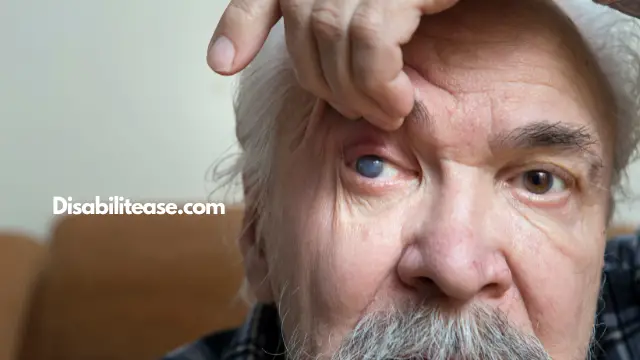Can you be blind in one eye? It is possible to develop complete blindness in one of your eyes without bearing any loss on the other one. The condition is medically known as monocular vision or amaurosis fugax.

Most acquired cases of single-eye blindness happen due to a complication with the blood vessels.
Blood supply plays an important role in the overall quality of vision, and restricted blood flow either due to blood pressure, blood clots, eye strokes, and diabetes can lead to the development of blindness. Keep reading to learn about the most common causes and their possible treatments.
Here is a related article that might interest you on Do Blind People Sleep With Their Eyes Open?
Table of Contents
Can You Be Blind In One Eye? What Is An Eye Stroke?
An eye stroke can result from restricted blood flow within the eyes. The blood flow is responsible for supplying oxygen to the retina – light-responsive tissue that transmits light signals to the brain to help it form a picture.
Blocked or narrow arteries can restrict the flow of blood to the retina, leading to gradual weakening and death of optical nerve cells. If this blood supply is not immediately restored with the help of medication and surgery, the condition can lead to permanent blindness.
Experts estimate that nearly 12,000 people are affected by an eye stroke annually. Eye strokes are considered a serious medical emergency and must be treated with hospitalization within the first 6-12 hours. Untreated strokes can lead to irreversible causes of blindness in one or both eyes.
You are more likely to experience an eye stroke if you are over the age of 60, have stage I or II diabetes, cardiovascular disease, or suffer from high blood pressure. It’s important to note that the stroke does not cause blindness or vision impairment immediately but can gradually lead to it.
While the symptoms are very subtle and may not seem like a stroke, even a 6-hour delay in treatment can cause serious vision loss complications.
Treatment For Eye Stroke
Complete blindness as a result of eye stroke is currently irreversible and cannot be cured. However, cases of permanent blindness are also rare, and most strokes only lead to partial vision loss. The best treatments available for treating eye strokes are explained below.
Clot-Busting Medication
The treatment includes direct injection of Tissue Plasminogen Activator (Tpa). The injection helps dissolve clots responsible for restricting blood flow within the retinal blood vessels.
Hyperbaric Oxygen Therapy
The therapy is used to deliver concentrated oxygen within your bloodstream to help the nerve cells and retinal tissue receive the vital supply they need to maintain vision. The intensity and duration of treatment may vary depending on the severity of your vision loss.
Retinal Detachment
Retinal Detachment is a rare condition where the retina becomes thinner and begins to detach from the essential blood vessels. Because these blood vessels are responsible for supplying oxygen and nutrients to the retina, the gradual pulling away can lead to vision loss in one or both eyes.
Once the retina becomes detached, it cannot transfer visual signals to the brain anymore, thereby leading to blindness. While it affects only 1 in 10,000 individuals, the risk increases with diabetes, older age, and high blood pressure.
The condition can result in sudden vision loss in both one or part of the eye. Before sudden, complete blindness, the gradually detaching retina will give less severe warning signs at first.
These signs can include a blurry or distorted vision in the affected eye, small dark spots over the visual field, and rapid flashes of black light covering the visual field. Downplaying these warning signs can lead to irreversible blindness in one or both eyes.
Freeze Treatment
Freeze treatment is used to treat cases with smaller tears in the retina. The treatment involves using freezing probes or lasers to seal the tear to prevent further Detachment.
Surgery
Surgery may be required if your retina has become severely detached from the blood vessels and needs to be brought back into place. Your surgeon will assess the severity and positioning of the Detachment and move and connect the retina back to the blood vessels.
Glaucoma
Glaucoma can arise due to multiple factors, including high blood pressure, diabetes, eye injury, and genetic predisposition. It can increase the intraocular pressure within the eye or restrict blood flow responsible for healthy optic nerve function.
This can result in damaged optic nerves – the cluster of nerves responsible for maintaining the eye-to-brain visual link. The symptoms usually appear very slowly, and affected individuals may not notice an immediate change in their vision.
However, untreated Glaucoma can lead to permanent blindness in one or both eyes. Its early warning signs include deteriorating peripheral vision, blurry vision, or persistent eye pain.
Treatment for Glaucoma

There is currently no treatment available for bringing back vision loss due to Glaucoma. However, if you are at the early stages and face minimal vision loss, further damage can be prevented through surgery and fluid drainage.
Laser Therapy
Laser therapy is used if your Glaucoma results from clogged meshwork that prevents proper drainage of eye fluid. Your doctor will use medical lasers to open up the clogged channels to recover the natural passage of drainage.
Drainage Tubes
Drainage tubes may be used to remove the accumulation of excess fluid within your eye, which is responsible for curtaining your vision. The drainage helps relieve the intraocular pressure within the eyes and prevent further vision damage.
Diabetes as a Cause
Diabetes is the most common cause of acquired vision impairment and blindness. Individuals with diabetes are 3-5 times more likely to develop Glaucoma, Retinal Detachment, eye strokes, and vitreous hemorrhage.
Diabetes increases the level of glucose present within your bloodstream, which leads to severe tissue and blood vessel damage over time. These damaged blood vessels can prevent the optic nerves and retina from receiving an adequate supply of oxygen, leading to vision loss and blindness. A common cause of single-eye blindness due to diabetes is the development of Diabetic Retinopathy.
Diabetic Retinopathy
The condition starts within the blood vessels present in the retina, where it creates tiny swollen dots that can lead to restricted blood flow. Over time, the condition can become more serious and attacks the macula – an essential part of the eye responsible for communicating the front visual field to the brain.
Depending on each case, it can lead to blurry vision and dark spots in one or both eyes. However, this stage cannot cause complete blindness.
When left untreated, the case can develop into a Proliferative Diabetic Retinopathy, which can cause hemorrhage and then blindness. While there has been significant progress in available treatments, blindness caused by retinopathy doesn’t have a cure.
In cases of single-eye blindness, the damage can reach the other eye over time and cause complete blindness in both eyes. Prevention is, therefore, the best cure, and early diagnosis can help you maintain a healthy vision.
Treatments for Retinopathy
- Laser treatment
Advanced stages of retinopathy lead the body to create compensatory blood vessels that are weak and cause further damage. Laser treatment is used to stop the growth of these blood vessels and prevent further damage to vision. However, it cannot help bring back previously lost vision.
- Eye injections
Eye injections are also used to prevent the growth of new blood vessels. They are particularly helpful at the middle stage of the disease- maculopathy, and can help revive some of the lost vision.
Another post that will interest you is about Can A Blind Person Get An Eye Transplant?

Hi, my name is Eddie, I am a professional trainer specializing in the elderly population and I’m also a website designer. I love training in the gym, going to the beach, traveling, and having good food.
I combined my love for sport and website designing to make “DisabilitEase” whose purpose is to help elderly and disabled people live a more full and active life, have more fun, and enjoy their unique journey despite any disability.



